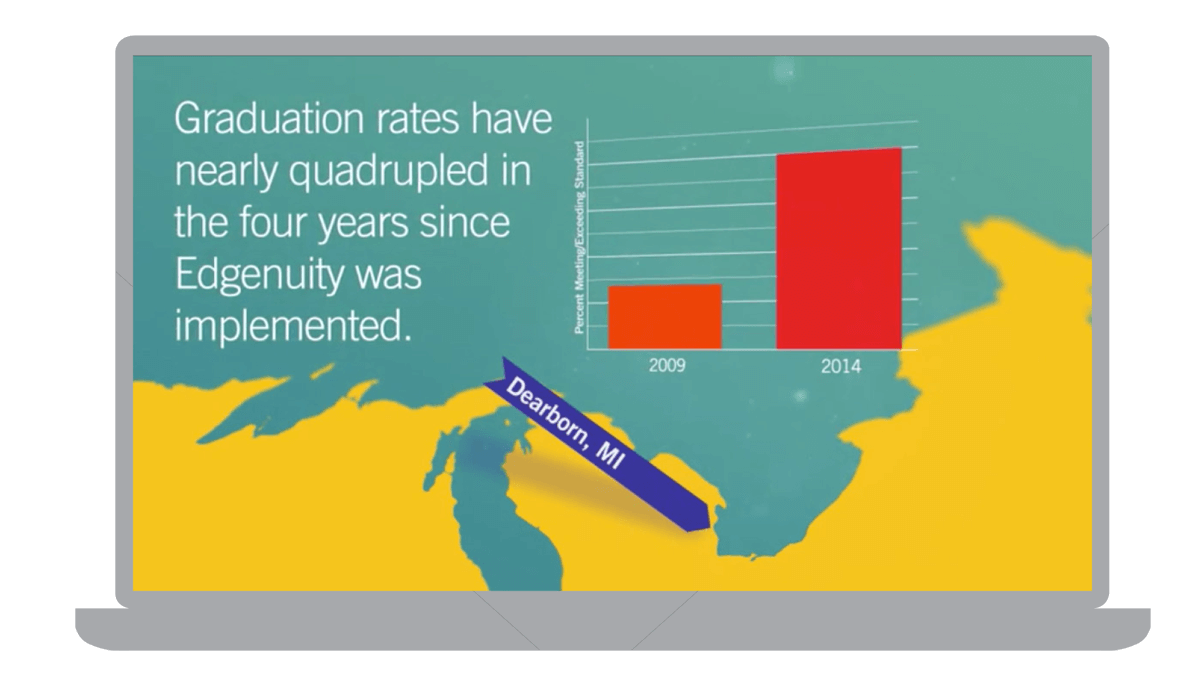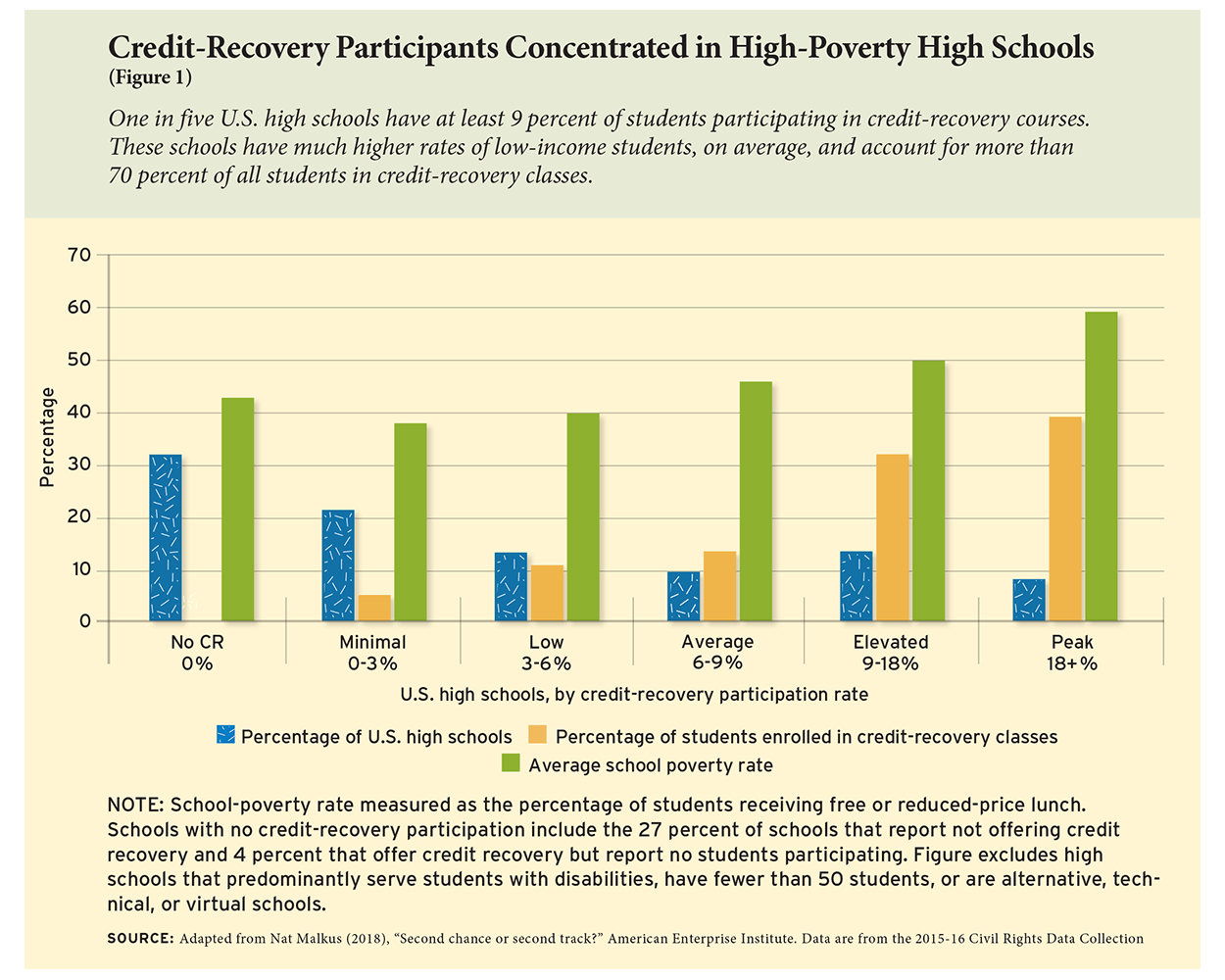
In 2018, the high-school graduation rate in Newburgh, New York, climbed to 78 percent, up from 66 percent just five years earlier. It was happy news for the tough-minded city about an hour’s drive north of Manhattan, known more in recent decades for its high rates of violent crime than the stately homes that line its parks and thoroughfares. About two thirds of the school district’s 12,000 students are from low-income families, and nearly one in six are English language learners. Connecting more students to diplomas and productive postsecondary work or study was a critical goal for the district and the city as a whole.
Central to this success was Newburgh’s use of online credit-recovery classes.
For decades, high-school students who failed a required class were presented with two unappealing options: either repeat the course next year or during summer school. But in recent years, online credit recovery has emerged as a third way. Students who fail a course can enroll in a computer-based version of the class without waiting, quickly progress through required material, earn the missing credits, and, in some cases, improve their grade-point average. When implemented well, online credit-recovery classes can be a lifeline to struggling students, providing personalized learning experiences and a path to graduation. But these classes also may be vulnerable to abuse—not only by students keen to post a positive outcome, but also by schools and districts eager to raise high-school graduation rates.
That was apparently the case in Newburgh, where an investigation by the local district attorney’s office uncovered myriad abuses by educators that artificially inflated student performance, including changing grades, giving students unlimited opportunities to take identical tests and quizzes, and awarding credits to students who did not actually attend class. In response, the district has stopped offering online credit-recovery classes and launched its own investigation into the practice.
However, “we understand instructional technology is not going anywhere,” Superintendent Roberto Padilla recently said during a local school-board meeting. “We need to give students opportunities, not take them away, but we need to partner with organizations that meet our needs. We’ll be looking for programs that provide tighter structures.”
What actually happens during online credit-recovery courses? A look at recent headlines reveals reasons for concern. The flexibility of online credit-recovery programs can help educators meet students’ diverse needs, but it may also hamper efforts to ensure that coursework is rigorous. That may undermine students’ longer-term success.
An enticing solution
Between 2011 and 2017, the U.S. graduation rate rose to an all-time high of 85 percent from 79 percent. During that same period, average math and reading test scores on college-entrance exams and the National Assessment of Educational Progress remained flat. If more U.S. students are graduating but these same students on average are not showing increased academic achievement, something else must explain the phenomenon. Either the bar to graduate high school has been lowered, or schools are providing more supports in order to help more students meet the standard. How does the rapid rise of online credit-recovery programs fit into the picture?
The concept of credit recovery is not new: high-school students have long had the opportunity to retake a failed course. But in length and format, those makeup classes weren’t dramatically different from the initial course. That has changed in the past decade, as online programs taught with varying levels of adult supervision have proliferated and, in many cases, replaced the traditional model of credit recovery.
That change is largely attributable to the confluence of two forces, said John Watson, the founder of Evergreen Education Group, an education research and consulting company focused on digital learning. First, federal legislation starting with the No Child Left Behind Act of 2001 set clear incentives for high schools to boost graduation rates, because they faced punishing consequences if their rates were too low. In allowing struggling students to quickly make up courses, online credit recovery emerged as one enticing tool to keep more students on the path to graduation. Current law under the Every Student Succeeds Act of 2015 established some flexibility on that measure but also requires intervention at schools with graduation rates below 67 percent. The pressure to improve graduation rates seems unlikely to lessen anytime soon.
Second, through programs like the ConnectED initiative, federal agencies and private companies made a multibillion-dollar investment to improve broadband access and technology in schools and libraries nationwide. A vast and lucrative education-technology market emerged, offering digital products and programs that promised to provide students with more personalized instruction. At the same time, educators were exploring new types of lessons that did the same, trading top-down, lockstep curricula for more flexible models that could meet the changing needs of individual students from day to day.
Online credit-recovery programs have ridden the crest of all these trends, combining personalized learning and digital tools in response to a nationwide call to increase high-school graduation rates. Today, some 89 percent of high schools nationwide offer at least one credit-recovery course, and as many as 15 percent of all students take such a class, according to a U.S. Department of Education survey of school leaders in the 2014–15 school year. Such coursework is more prevalent at schools serving larger numbers of low-income students than those in wealthier communities (see Figure 1). The formats of those courses differ: 71 percent of schools offer courses online, 46 percent support blended courses that combine direct instruction with online work, and 42 percent provide traditional in-person classroom instruction.
“The horse is out of the barn”
Despite the widespread use of credit-recovery programs, remarkably little is known about how schools adopt and implement them and whether students are actually benefiting from their use. In 2015, the U.S. Department of Education’s Institute of Education Sciences conducted a research review but was “unable to draw any research-based conclusions about the effectiveness or ineffectiveness of credit recovery programs.” In the 2019 “Building a Grad Nation” report, researchers from Civic and the Johns Hopkins School of Education wrote that “given the lack of comprehensive knowledge on the rigor of the most widely adopted credit recovery programs, it is difficult to understand the true impact of these courses.”
Among researchers’ greatest concerns is that online credit-recovery courses lack rigor and are easy for students or educators to exploit. “We don’t know a lot about the rigor and what we do know seems to indicate that the rigor isn’t all that stringent,” said Matthew Atwell, a researcher at Civic who coauthored the report.
In a recent study, researchers Carolyn J. Heinrich and Jennifer Darling-Aduana examined online courses in the Milwaukee Public Schools. They found that by the 2016–17 school year, 40 percent of graduating seniors had completed at least one online course, the majority of which were taken for the purpose of credit recovery. The study found positive effects for online students on the number of credits earned and whether they graduated high school and enrolled in college. However, in a related study, they found mostly negative associations between online course taking and students’ math and reading test scores. The results suggest that “on average, online course-taking is not . . . reflecting real learning, and some students may even be set back in their learning,” the authors wrote.
Through classroom observations and interviews with students and teachers, the study uncovered several potential explanations for the uneven learning gains, such as disengaged students using Google to copy and paste answers to assignments and limited interaction between students and teachers. “If the students were already struggling in a traditional classroom, most likely they’re going to need more help, not less,” Heinrich said in an interview.
A 2016 study by the American Institutes for Research compared student performance in online and in-person credit-recovery classes for Algebra I among a group of 1,200 high-school freshmen in Chicago. Two thirds of online students passed the class, compared to three quarters of in-person students. Online students also were more likely to describe the course as “difficult” and scored lower on an end-of-course test than students assigned to a traditional face-to-face classroom. However, their longer-term outcomes were similar: they earned comparable grades in subsequent math classes, and about 47 percent of students from each group earned their diplomas on time.
“For most kids that fail courses, who are probably at risk in a number of different ways . . . an online course, in the absence of really phenomenal technological advances, is probably not enough to help them regain content that they haven’t gotten,” Jessica Heppen, the study’s lead author, said in an interview. “So I do have a lot of concerns about the widespread use of online courses for credit recovery with so many unanswered questions.”
Still, Heppen acknowledged that online credit recovery, now used in most high schools, is unlikely to go away soon. “I always say, ‘the horse is out of the barn.’ This is happening anyway and so I don’t think there’s a way to kind of pull back on it, but I do think it makes sense to exercise some caution and to think about individual kids and their needs.”

A booming market
Most online credit-recovery courses are developed, maintained, and sold to districts by private for-profit companies. Two of the largest vendors are Apex Learning, which is used in nearly 2,000 school districts, and Edgenuity, in 8 of the nation’s 10 largest districts. Districts typically pay about $250 for each student who accesses the online courses, though costs vary significantly among vendors based on the size of the district.
The process by which districts vet potential providers of online courses varies. In some cases, districts form committees to review the online courses. In other instances, the process is much less formal. For example, Houston Independent School District “had several students from across the district try out different courses across different platforms,” said Maria Bonilla, the district’s virtual-instruction program manager. “The students selected Apex as the one they preferred over the other ones.”
Other districts essentially take a trial-and-error approach, contracting with a company until concerns about rigor, quality, or cost prompt them to go shopping for a new provider. In Memphis, Tennessee, Shelby County Schools has gone through three or four vendors since 2008, according to Vinson Thompson, the director of online learning.
Such informality extends to the regulatory level as well: on the whole, state leaders have set few standards for online credit-recovery companies to meet. An analysis last year from the Education Commission of the States found that “relatively few states have adopted state-level credit-recovery policies, including definitions of and mechanisms for regulating credit recovery.” And a Slate investigation in 2017 found that “while many state education departments have started to review online education providers, few bar districts from using companies that don’t meet their standards.”
With minimal state guidelines and a limited research base, many districts choosing among online course providers are left to rely on the information provided by the companies themselves. That can be a problem for districts that don’t know what to look for, said Christine Voelker, the K–12 program director for Quality Matters, a nonprofit organization that reviews online courses.
“There are providers who have marketing teams and they’re good at what they do,” she said. “They might have flashy content, and things that will wow you and things that are very much eye candy. If you’re not knowledgeable about what you are looking for, you’re going to fall into that trap of saying, ‘this is a really cool-looking course,’ but it might not be hitting those learning objectives that you want your students to hit.”
Indeed, reviewing some of the vendors’ marketing materials reveals claims that, at best, lack context, and at worst, appear designed to mislead. One promotional video on Edgenuity’s website touts a graduation rate that “nearly quadrupled” at Dearborn Magnet High School in Michigan in the four years that its courses were implemented. Not mentioned is the fact that Dearborn Magnet is a small alternative school that graduates fewer than 10 students each year. Or that the graduation rate has since swung wildly up and down even as the school continues to use Edgenuity.
“For that particular school, that was something to celebrate,” said Deborah Rayow, a vice president of Edgenuity, when asked about Dearborn Magnet. While the company’s website does feature independent research studies of some of its other digital products, those focused on its credit-recovery programs were conducted internally and often provide little explanation of methodology.

Implementation matters
The vendor chosen by school districts is just one of several factors that affect students’ experiences in online credit-recovery courses. How teachers interact with and support online credit-recovery courses has major effects on student success, as do district and state policies that dictate the grading and oversight of such classes.
Indeed, the resources that schools put in place to support online learning may have a much greater impact on students’ success than the particular vendor a school chooses. For starters, teachers need technical training on how to use the online platform. They need to have strategies to keep kids engaged and ensure students are actually doing the work instead of using an Internet search engine to look up and copy the answers. And schools need to keep class sizes manageable so that teachers can provide individualized feedback and support. In the Milwaukee study, for example, researchers observed teachers struggling to manage large groups of students, saw scant substantive interaction between teachers and students, and noted that students were frequently distracted by their cell phones or other websites.
John Watson of the Evergreen Education Group said in most cases, the biggest determining factor is the quality of the student-teacher relationship.
There is also tremendous variation in what district and state credit-recovery policies, standards, and regulations look like—if they exist at all. That makes it nearly impossible to know just what instruction looks like in practice from high school to high school. Some programs are condensed face-to-face classes, others are completely online, and still others are “blended,” in which students work in a computer lab with support from a certified teacher. In some districts, courses are graded on a pass/fail basis, while in others students can earn scores up to 100 percent. Some districts cap the number of credit-recovery courses a student can time at one time, while others don’t. Some districts require students take paper-and-pencil assessments proctored by a teacher, while others allow testing to be completed at home on a computer. Some online classes are used to make up parts of a course, while others are designed as a wholesale replacement.
This variation is by design. One of the main appeals of credit-recovery programs is their flexibility and adaptability. Particularly when using online platforms, students can move through the course at their own pace and can skip large sections if they do well enough on a pre-assessment. Teachers and administrators are typically given wide latitude in deciding, for example, how many attempts students are given to pass a quiz and what score is needed to pass.
But this key strength can present a vulnerability. Credit recovery, including online programs, has been at the center of several scandals in recent years.
In Newburgh, a former teacher and coach lodged complaints with the local district attorney’s office and state education department in 2017, alleging massive problems with chronic absenteeism and manipulation of student-athlete records at the district’s high school, the Newburgh Free Academy. A resultant investigation culminated in a damning 89-page report by a grand jury that a local judge released to the public in April 2019, detailing major misuse by district staff of two software programs: Apex, the online credit-recovery course software, and Infinite Campus, which was used to track attendance.
In precise detail, the report documented the ways teachers and administrators at district high schools misused the Apex credit-recovery software to boost graduation rates artificially. The grand jury found that between 2016 and 2018, dozens of teachers overseeing the program made a total of more than 1,000 grade overrides to scored assessments. One teacher had altered students’ grades 325 times and some grades had been changed nearly five months after a test was taken. Students were allowed an unlimited number of opportunities to retake tests and quizzes. In a large number of cases, students had completed the online courses in an “unusually short” amount of time: one student completed the course in 18 minutes. And dozens of students earned course credit despite not meeting attendance requirements.
By design, Apex can be customized by educators, just as they customize traditional classroom instruction to fit student needs, according to Apex Learning’s chief executive officer, Cheryl Vedoe. She said that “almost every feature” of an online program can be turned on or off by the course administrator.
“When they’re teaching the traditional material, teachers every day make those judgment calls, when they’re grading student work and they’re giving students the opportunity to make things up,” she said. “You know, teachers as professionals do that every day with a more traditional curriculum.”
The Newburgh report, however, stated that testimony from teachers “revealed blind administration of a program of learning that ultimately served as a disservice to the students most in need of it . . . but which nonetheless serve the Newburgh Free Academy’s interests in increased graduation rates. The motivation to continue to operate the program in such a way is therefore clear.”
A spokesperson for the Newburgh school district declined to comment for this story, citing an ongoing investigation by the New York State Education Department. But the district has shared details of its response through public meetings, including a detailed presentation in April that notes it suspended its use of Apex and is designing a “second chance” evening school for students who need credit-recovery options.
“So much we don’t know”
It’s important not to conflate the abuse of credit recovery that occurred in Newburgh with well-intentioned efforts that may or may not actually help students. But the Newburgh example demonstrates the many ways online credit-recovery programs may function without academic integrity and ultimately undermine, rather than support, learning.
In recent years, dispatches from North Carolina, Florida, San Diego, and Washington, D.C.—to name a few—have described programs operated with little oversight and few safeguards to ensure students are being properly graded and awarded credit. Some states are starting to take action: the North Carolina State Board of Education, for example, is requiring all districts to develop clear policies for credit recovery.
Tougher still is the question of academic quality. The proliferation of online credit recovery is a logical development given the incentives that are baked in to current education policies. The era of accountability that No Child Left Behind ushered in—and that the Every Student Succeeds Act has continued to a lesser extent—placed tremendous pressure on districts to raise graduation rates, or face consequences. At the same time, states have mostly failed to put in place the kind of oversight and regulations that would ensure rigor and quality are not sacrificed in the pursuit of higher graduation rates. The result is that states are incentivizing districts to boost graduation rates while placing a great deal of trust in districts and private vendors to preserve rigor and quality in the process.
There are potential tools to ensure rigor that states and districts could explore. Three states, for example, require students to pass an objective, external exam to recover credit for a course: Georgia, Louisiana, and New York. But most leave it to districts to set policies around vetting, adopting, and implementing credit-recovery courses.
States also could expand their use of end-of-course exams, which require students to show they have mastered certain knowledge and skills in required subjects. While far from universal, such exams have been used in 32 states and the District of Columbia since they first appeared in the 1990s, and are intended to serve as an external yardstick for specific coursework, helping to set and uphold academic standards.
An August 2019 study by Adam Tyner and Matthew Larsen found end-of-course exams generally positively correlated with high-school graduation rates. The exams “can be deployed without ‘stakes’ but with their results publicly reported so as to tamp down on grade inflation or abuse of credit-recovery programs,” the authors wrote.
It’s likely that many school districts are using credit recovery thoughtfully, with the necessary supports and resources in place to maximize student success and hold students accountable for their learning. But without additional information about how these programs are being adopted and implemented, “there’s just so much we don’t know,” Atwell, the Civic researcher, said.
As for the software companies, they say there’s only so much they can do. Edgenuity and other vendors can’t dictate the use of their materials “any more than a publisher of a textbook could,” said Rayow.
“I think anyone who has been in school has been in classes where textbooks were used for good and where textbooks were used for not so good,” she said. “The same is true for digital education.”
David Loewenberg is a freelance writer based in Washington, D.C.
This article appeared in the Winter 2020 issue of Education Next. Suggested citation format:
Loewenberg, D. (2020). A Digital Path to a Diploma: Online credit-recovery classes are a lifeline—and ripe for abuse. Education Next, 20(1), 50-56.



